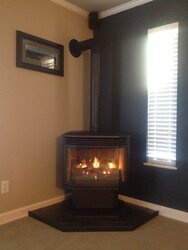Hello all, I bought a Majestic FS42rp last year used. The last couple of months I took everything apart and converted it from propane to natural gas. I got the kit straight from Vermont castings. I had to replace 3 burner jets, the pilot jet, and a few parts in the regulator. Everything is working great! nice clean burn, pilot light is burning nice and the pattern of the pilot light is even and touching the thermo sensors.
When I install the first sealed glass door the pilot light remains lit and will run just fine. But as soon as I turn on the burners the pilot light will start to fade away and the flame is not contacting the thermo sensor anymore. Eventually the sensor cools down and shuts the regulator down and all burners and pilot will go out. The only takes a matter or 30 seconds to 2 mins. If I have the glass door off then the pilot light stays strong and will run for hours.
Out of things to try, I started backing a brass slotted screw out of the regulator. Located on the lower left side if you are facing the regulator. I was able to get the pilot flame to stay lit by doing this for a couple of days. But this morning the same thing started to happen again. To me it looks like its running out of air to burn once the main burners are turned on.
If anyone has any experience at solving this issue I would love to hear it. All of my intake holes "3" are clear and clean. I just installed the stove and ran all new type B exhaust pipe. It ran for several hours last night but cant seem to get the pilot light to stay lit on the side where the thermo sensor is.
Thanks,
Garrett
When I install the first sealed glass door the pilot light remains lit and will run just fine. But as soon as I turn on the burners the pilot light will start to fade away and the flame is not contacting the thermo sensor anymore. Eventually the sensor cools down and shuts the regulator down and all burners and pilot will go out. The only takes a matter or 30 seconds to 2 mins. If I have the glass door off then the pilot light stays strong and will run for hours.
Out of things to try, I started backing a brass slotted screw out of the regulator. Located on the lower left side if you are facing the regulator. I was able to get the pilot flame to stay lit by doing this for a couple of days. But this morning the same thing started to happen again. To me it looks like its running out of air to burn once the main burners are turned on.
If anyone has any experience at solving this issue I would love to hear it. All of my intake holes "3" are clear and clean. I just installed the stove and ran all new type B exhaust pipe. It ran for several hours last night but cant seem to get the pilot light to stay lit on the side where the thermo sensor is.
Thanks,
Garrett


